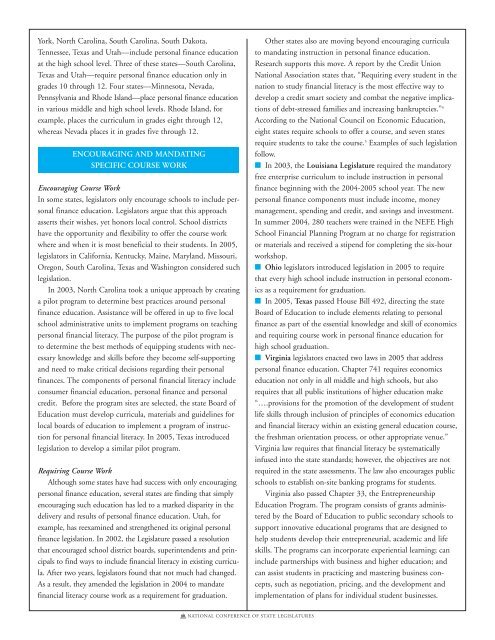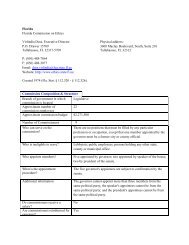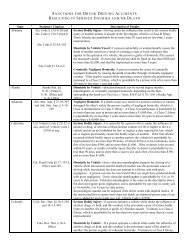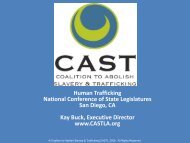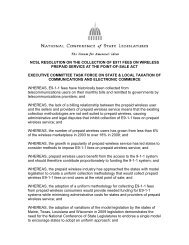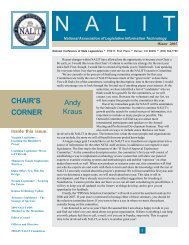Printer Friendly Version - National Conference of State Legislatures
Printer Friendly Version - National Conference of State Legislatures
Printer Friendly Version - National Conference of State Legislatures
Create successful ePaper yourself
Turn your PDF publications into a flip-book with our unique Google optimized e-Paper software.
York, North Carolina, South Carolina, South Dakota,<br />
Tennessee, Texas and Utah—include personal finance education<br />
at the high school level. Three <strong>of</strong> these states—South Carolina,<br />
Texas and Utah—require personal finance education only in<br />
grades 10 through 12. Four states—Minnesota, Nevada,<br />
Pennsylvania and Rhode Island—place personal finance education<br />
in various middle and high school levels. Rhode Island, for<br />
example, places the curriculum in grades eight through 12,<br />
whereas Nevada places it in grades five through 12.<br />
ENCOURAGING AND MANDATING<br />
SPECIFIC COURSE WORK<br />
Encouraging Course Work<br />
In some states, legislators only encourage schools to include personal<br />
finance education. Legislators argue that this approach<br />
asserts their wishes, yet honors local control. School districts<br />
have the opportunity and flexibility to <strong>of</strong>fer the course work<br />
where and when it is most beneficial to their students. In 2005,<br />
legislators in California, Kentucky, Maine, Maryland, Missouri,<br />
Oregon, South Carolina, Texas and Washington considered such<br />
legislation.<br />
In 2003, North Carolina took a unique approach by creating<br />
a pilot program to determine best practices around personal<br />
finance education. Assistance will be <strong>of</strong>fered in up to five local<br />
school administrative units to implement programs on teaching<br />
personal financial literacy. The purpose <strong>of</strong> the pilot program is<br />
to determine the best methods <strong>of</strong> equipping students with necessary<br />
knowledge and skills before they become self-supporting<br />
and need to make critical decisions regarding their personal<br />
finances. The components <strong>of</strong> personal financial literacy include<br />
consumer financial education, personal finance and personal<br />
credit. Before the program sites are selected, the state Board <strong>of</strong><br />
Education must develop curricula, materials and guidelines for<br />
local boards <strong>of</strong> education to implement a program <strong>of</strong> instruction<br />
for personal financial literacy. In 2005, Texas introduced<br />
legislation to develop a similar pilot program.<br />
Requiring Course Work<br />
Although some states have had success with only encouraging<br />
personal finance education, several states are finding that simply<br />
encouraging such education has led to a marked disparity in the<br />
delivery and results <strong>of</strong> personal finance education. Utah, for<br />
example, has reexamined and strengthened its original personal<br />
finance legislation. In 2002, the Legislature passed a resolution<br />
that encouraged school district boards, superintendents and principals<br />
to find ways to include financial literacy in existing curricula.<br />
After two years, legislators found that not much had changed.<br />
As a result, they amended the legislation in 2004 to mandate<br />
financial literacy course work as a requirement for graduation.<br />
NATIONAL CONFERENCE OF STATE LEGISLATURES<br />
Other states also are moving beyond encouraging curricula<br />
to mandating instruction in personal finance education.<br />
Research supports this move. A report by the Credit Union<br />
<strong>National</strong> Association states that, “Requiring every student in the<br />
nation to study financial literacy is the most effective way to<br />
develop a credit smart society and combat the negative implications<br />
<strong>of</strong> debt-stressed families and increasing bankruptcies.” 4<br />
According to the <strong>National</strong> Council on Economic Education,<br />
eight states require schools to <strong>of</strong>fer a course, and seven states<br />
require students to take the course. 5 Examples <strong>of</strong> such legislation<br />
follow.<br />
■ In 2003, the Louisiana Legislature required the mandatory<br />
free enterprise curriculum to include instruction in personal<br />
finance beginning with the 2004-2005 school year. The new<br />
personal finance components must include income, money<br />
management, spending and credit, and savings and investment.<br />
In summer 2004, 280 teachers were trained in the NEFE High<br />
School Financial Planning Program at no charge for registration<br />
or materials and received a stipend for completing the six-hour<br />
workshop.<br />
■ Ohio legislators introduced legislation in 2005 to require<br />
that every high school include instruction in personal economics<br />
as a requirement for graduation.<br />
■ In 2005, Texas passed House Bill 492, directing the state<br />
Board <strong>of</strong> Education to include elements relating to personal<br />
finance as part <strong>of</strong> the essential knowledge and skill <strong>of</strong> economics<br />
and requiring course work in personal finance education for<br />
high school graduation.<br />
■ Virginia legislators enacted two laws in 2005 that address<br />
personal finance education. Chapter 741 requires economics<br />
education not only in all middle and high schools, but also<br />
requires that all public institutions <strong>of</strong> higher education make<br />
“….provisions for the promotion <strong>of</strong> the development <strong>of</strong> student<br />
life skills through inclusion <strong>of</strong> principles <strong>of</strong> economics education<br />
and financial literacy within an existing general education course,<br />
the freshman orientation process, or other appropriate venue.”<br />
Virginia law requires that financial literacy be systematically<br />
infused into the state standards; however, the objectives are not<br />
required in the state assessments. The law also encourages public<br />
schools to establish on-site banking programs for students.<br />
Virginia also passed Chapter 33, the Entrepreneurship<br />
Education Program. The program consists <strong>of</strong> grants administered<br />
by the Board <strong>of</strong> Education to public secondary schools to<br />
support innovative educational programs that are designed to<br />
help students develop their entrepreneurial, academic and life<br />
skills. The programs can incorporate experiential learning; can<br />
include partnerships with business and higher education; and<br />
can assist students in practicing and mastering business concepts,<br />
such as negotiation, pricing, and the development and<br />
implementation <strong>of</strong> plans for individual student businesses.


